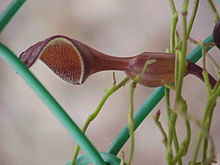Aristolochia maxima
Appearance
| Aristolochia maxima | |
|---|---|

| |
| Scientific classification | |
| Kingdom: | Plantae |
| Clade: | Tracheophytes |
| Clade: | Angiosperms |
| Clade: | Magnoliids |
| Order: | Piperales |
| Family: | Aristolochiaceae |
| Genus: | Aristolochia |
| Species: | A. maxima
|
| Binomial name | |
| Aristolochia maxima Jacq.
| |
| Synonyms[1][2] | |
| |
Aristolochia maxima is a plant species native to Central and South America, naturalized in southern Florida. Common names include Florida Dutchman's-pipe (US), canastilla (Guatemala), guaco (El Salvador), and tecolotillo (Mexico).[1] In Florida, it grows in hammocks in the Everglades at elevations below 50 m (170 feet).[3]
Aristolochia maxima is a liana (woody vine) that can reach a height of 20 m (67 feet), twining over other plants. Leaves are truncate to cuneate at the base. Flowers are brownish-purple.[4][5][6][7]
References
- ^ a b Tropicos
- ^ The Plant List
- ^ Flora of North America v 3.
- ^ Jacquin, Nicolaus (Nicolaas) Joseph von. Enumeratio Systematica Plantarum, quas in insulis Caribaeis 30. 1760.
- ^ Cook, K. 2001. Aristolochiaceae. 85(1): 229–233. In W. D. Stevens, C. Ulloa Ulloa, A. Pool & O. M. Montiel Jarquín (eds.) Flora de Nicaragua Monographs in Systematic Botany from the Missouri Botanical Garden, Missouri Botanical Garden, St. Louis.
- ^ González Garavito, F. A. 1990. Aristolochiaceae. 12: 1–184. In J. O. Rangel, A. Cadena, G. Correal U., R. Bernal González & G. Lozano-Contreras (eds.) Flora de Colombia. Universidad Nacional de Colombia, Bogotá.
- ^ Nelson, C. H. 2008. Catálogo de las Plantas Vasculares de Honduras 1–1576.
